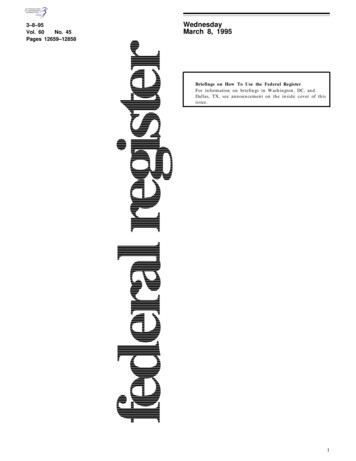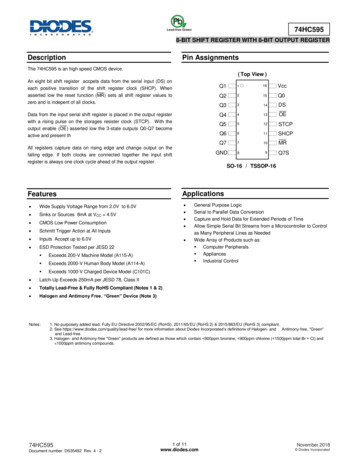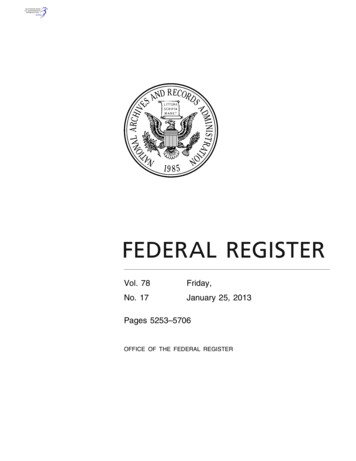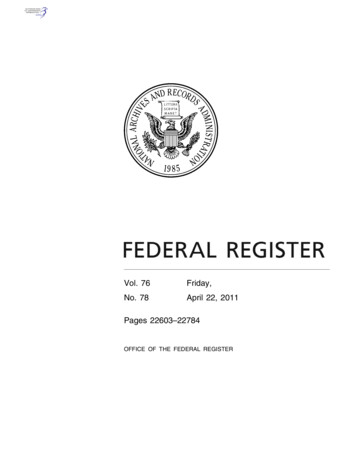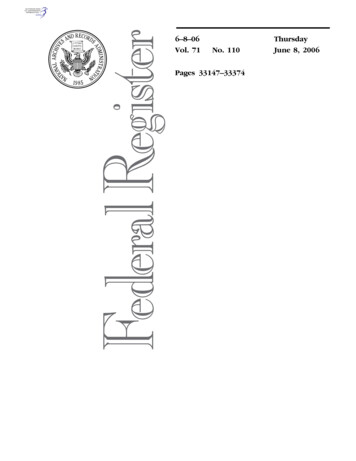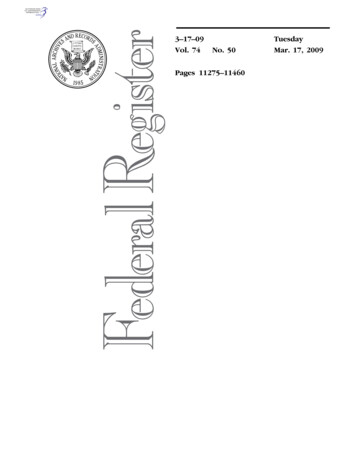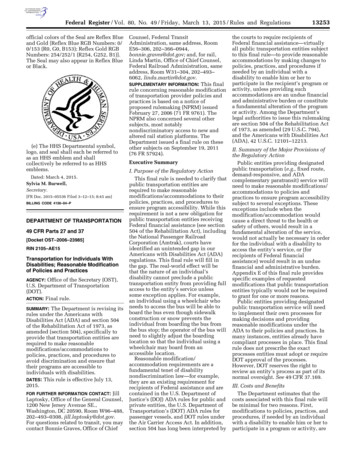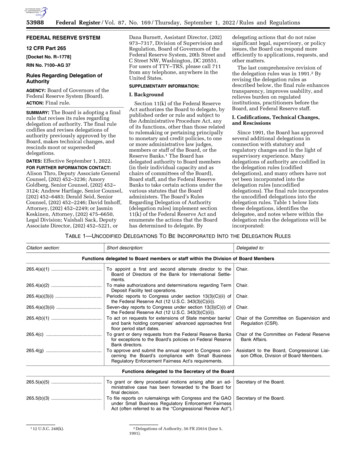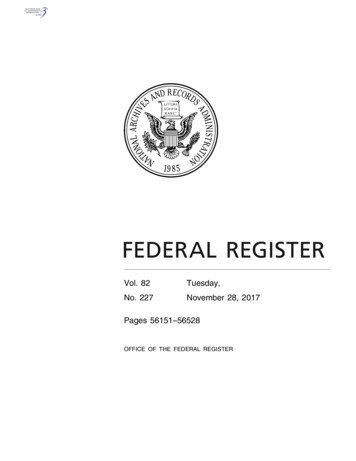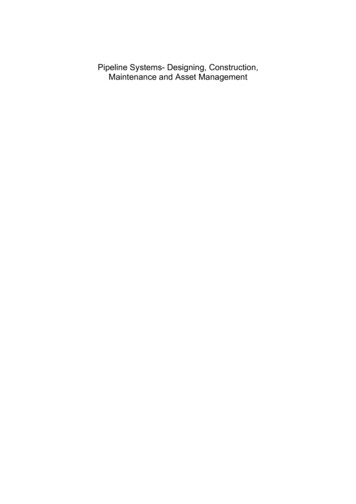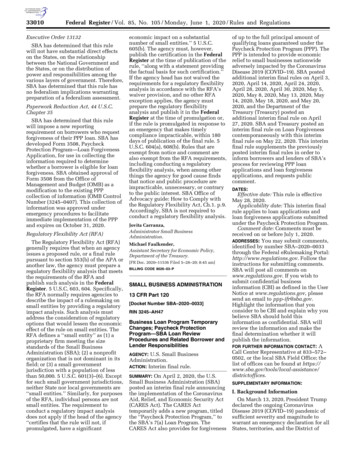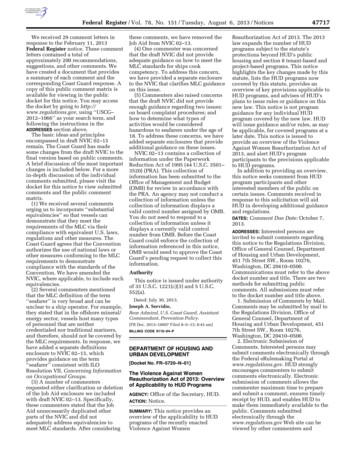
Transcription
tkelley on DSK3SPTVN1PROD with NOTICESFederal Register / Vol. 78, No. 151 / Tuesday, August 6, 2013 / NoticesWe received 29 comment letters inresponse to the February 11, 2013Federal Register notice. These commentletters contained a total ofapproximately 200 recommendations,suggestions, and other comments. Wehave created a document that providesa summary of each comment and thecorresponding Coast Guard response. Acopy of this public comment matrix isavailable for viewing in the publicdocket for this notice. You may accessthe docket by going to http://www.regulations.gov, using ‘‘USCG–2012–1066’’ as your search term, andfollowing the instructions in theADDRESSES section above.The basic ideas and principlesencompassed in draft NVIC 02–13remain. The Coast Guard has madesome changes from the draft NVIC to thefinal version based on public comments.A brief discussion of the most importantchanges is included below. For a morein-depth discussion of the individualcomments submitted, please visit thedocket for this notice to view submittedcomments and the public commentmatrix.(1) We received several commentsurging us to incorporate ‘‘substantialequivalencies’’ so that vessels candemonstrate that they meet therequirements of the MLC via theircompliance with equivalent U.S. laws,regulations and other measures. TheCoast Guard agrees that the Conventionauthorizes the use of national laws orother measures conforming to the MLCrequirements to demonstratecompliance with the standards of theConvention. We have amended theNVIC, where applicable, to include suchequivalencies.(2) Several commenters mentionedthat the MLC definition of the term‘‘seafarer’’ is very broad and can beunclear to a ship operator. For example,they stated that in the offshore mineral/energy sector, vessels host many typesof personnel that are neithercredentialed nor traditional mariners,and therefore, should not be covered bythe MLC requirements. In response, wehave added a separate definitionsenclosure to NVIC 02–13, whichprovides guidance on the term‘‘seafarer’’ consistent with ILOResolution VII, Concerning Informationon Occupational Groups.(3) A number of commentersrequested either clarification or deletionof the Job Aid enclosure we includedwith draft NVIC 02–13. Specifically,these commenters stated that the JobAid unnecessarily duplicated otherparts of the NVIC and did notadequately address equivalencies tomeet MLC standards. After consideringVerDate Mar 15 201019:47 Aug 05, 2013Jkt 229001these comments, we have removed theJob Aid from NVIC 02–13.(4) One commenter was concernedthat the draft NVIC did not provideadequate guidance on how to meet theMLC standards for ships cookcompetency. To address this concern,we have provided a separate enclosureto the NVIC that clarifies MLC guidanceon this issue.(5) Commenters also raised concernsthat the draft NVIC did not provideenough guidance regarding two issues:on board complaint procedures; andhow to determine what types ofactivities would be consideredhazardous to seafarers under the age of18. To address these concerns, we haveadded separate enclosures that provideadditional guidance on these issues.NVIC 02–13 contains a collection ofinformation under the PaperworkReduction Act of 1995 (44 U.S.C. 3501–3520) (PRA). This collection ofinformation has been submitted to theOffice of Management and Budget(OMB) for review in accordance withthe PRA. An agency may not conduct acollection of information unless thecollection of information displays avalid control number assigned by OMB.You do not need to respond to acollection of information unless itdisplays a currently valid controlnumber from OMB. Before the CoastGuard could enforce the collection ofinformation referenced in this notice,OMB would need to approve the CoastGuard’s pending request to collect thisinformation.AuthorityThis notice is issued under authorityof 33 U.S.C. 1221(c)(3) and 5 U.S.C.552(a).Dated: July 30, 2013.Joseph A. Servidio,Rear Admiral, U.S. Coast Guard, AssistantCommandant, Prevention Policy.[FR Doc. 2013–18897 Filed 8–5–13; 8:45 am]BILLING CODE 9110–04–PDEPARTMENT OF HOUSING ANDURBAN DEVELOPMENT[Docket No. FR–5720–N–01]The Violence Against WomenReauthorization Act of 2013: Overviewof Applicability to HUD ProgramsOffice of the Secretary, HUD.Notice.AGENCY:ACTION:This notice provides anoverview of the applicability to HUDprograms of the recently enactedViolence Against WomenSUMMARY:PO 00000Frm 00048Fmt 4703Sfmt 470347717Reauthorization Act of 2013. The 2013law expands the number of HUDprograms subject to the statute’sprotections beyond HUD’s publichousing and section 8 tenant-based andproject-based programs. This noticehighlights the key changes made by thisstatute, lists the HUD programs nowcovered by this statute, provides anoverview of key provisions applicable toHUD programs, and advises of HUD’splans to issue rules or guidance on thisnew law. This notice is not programguidance for any individual HUDprogram covered by the new law. HUDwill issue guidance and/or rules, as maybe applicable, for covered programs at alater date. This notice is issued toprovide an overview of the ViolenceAgainst Women Reauthorization Act of2013, and alert HUD’s programparticipants to the provisions applicableto HUD programs.In addition to providing an overview,this notice seeks comment from HUDprogram participants and otherinterested members of the public oncertain issues. Comments received inresponse to this solicitation will aidHUD in developing additional guidanceand regulations.DATES: Comment Due Date: October 7,2013.ADDRESSES: Interested persons areinvited to submit comments regardingthis notice to the Regulations Division,Office of General Counsel, Departmentof Housing and Urban Development,451 7th Street SW., Room 10276,Washington, DC 20410–0500.Communications must refer to the abovedocket number and title. There are twomethods for submitting publiccomments. All submissions must referto the docket number and title above.1. Submission of Comments by Mail.Comments may be submitted by mail tothe Regulations Division, Office ofGeneral Counsel, Department ofHousing and Urban Development, 4517th Street SW., Room 10276,Washington, DC 20410–0500.2. Electronic Submission ofComments. Interested persons maysubmit comments electronically throughthe Federal eRulemaking Portal atwww.regulations.gov. HUD stronglyencourages commenters to submitcomments electronically. Electronicsubmission of comments allows thecommenter maximum time to prepareand submit a comment, ensures timelyreceipt by HUD, and enables HUD tomake them immediately available to thepublic. Comments submittedelectronically through thewww.regulations.gov Web site can beviewed by other commenters andE:\FR\FM\06AUN1.SGM06AUN1
47718Federal Register / Vol. 78, No. 151 / Tuesday, August 6, 2013 / Noticesinterested members of the public.Commenters should follow theinstructions provided on that site tosubmit comments electronically.tkelley on DSK3SPTVN1PROD with NOTICESNote: To receive consideration as publiccomments, comments must be submittedthrough one of the two methods specifiedabove. Again, all submissions must refer tothe docket number and title of the document.No Facsimile Comments. Facsimile(FAX) comments are not acceptable.Public Inspection of PublicComments. All properly submittedcomments and communicationssubmitted to HUD will be available forpublic inspection and copying between8 a.m. and 5 p.m. weekdays at the aboveaddress. Due to security measures at theHUD Headquarters building, anappointment to review the publiccomments must be scheduled inadvance by calling the RegulationsDivision at 202–708–3055 (this is not atoll-free number). Individuals withspeech or hearing impairments mayaccess this number via TTY by callingthe Federal Relay Service at 800–877–8339. Copies of all comments submittedare available for inspection anddownloading at www.regulations.gov.FOR FURTHER INFORMATION: Forinformation about: HUD’s PublicHousing program, contact BeckyPrimeaux, Director, Public HousingManagement and Operations Division,Office of Public and Indian Housing,Room 4210, telephone number 202–402–6050; HUD’s Housing ChoiceVoucher program (Section 8) contactLaure Rawson, Director, HousingVoucher Management and OperationsDivision, Office of Public and IndianHousing, Room 4216, telephone number202–402–2425; HUD’s MultifamilyHousing programs, contact Catherine M.Brennan, Director, Housing AssistancePolicy Division, Office of Housing,telephone number 202–708–3000;HUD’s HOME Investment Partnershipsprogram, contact Virginia Sardone,Deputy Director, Office of AffordableHousing Programs, Office of CommunityPlanning and Development, Room 7164,telephone number 202–708–2684;HUD’s Housing Opportunities forPersons With Aids (HOPWA) program,please contact William Rudy, DeputyDirector, Office of HIV/AIDS Housing,Office of Community Planning andDevelopment, telephone number 202–708–1934; and HUD’s Homelessprograms, contact Ann Marie Oliva,Director, Office of Special NeedsAssistance, Office of CommunityPlanning and Development, telephonenumber 202–708–4300. The address forall offices is the Department of Housingand Urban Development, 451 7th StreetVerDate Mar 15 201019:47 Aug 05, 2013Jkt 229001SW., Washington, DC 20410. Thetelephone numbers listed above are nottoll-free numbers. Persons with hearingor speech impairments may access thesenumbers through TTY by calling thetoll-free Federal Relay Service at 800–877–8339.SUPPLEMENTARY INFORMATION:I. IntroductionOn March 7, 2013, President Obamasigned into law the Violence AgainstWomen Reauthorization Act of 2013(Pub. L. 113–4, 127 Stat. 54) (VAWA2013). VAWA 2013 reauthorizes andamends the Violence Against WomenAct of 1994, as previously amended,(title IV, sec. 40001–40703 of Pub. L.103–322, 42 U.S.C. 13925 et seq.) 1VAWA 2013, among other things,enhances judicial and law enforcementtools to combat violence against women;improves services for victims; enhancesservices, protection, and justice foryoung victims of violence; strengthensthe health care system’s response toviolence against women; and expandsprotections for Native American womenand immigrants. The provisions ofVAWA 2013 that are applicable to HUDprograms are found in title VI of VAWA2013, which is entitled ‘‘Safe Homes forVictims of Domestic Violence, DatingViolence, Sexual Assault, and Stalking.’’Section 601 of VAWA 2013 amendssubtitle N of VAWA (42 U.S.C. 14043eet seq.) to add a new chapter entitled‘‘Housing Rights.’’Section 4 of VAWA 2013, entitled‘‘Effective Date,’’ provides that ‘‘Exceptas otherwise specifically provided inthis Act, the provisions of titles I, II, III,IV, VII, and sections 3, 602, 901, and902 of this Act shall not take effect untilthe beginning of the fiscal yearfollowing the date of enactment of thisAct.’’ Section 601 of title VI, whichaddresses HUD programs, does not havea one-year delayed effective date.(Section 602 of title VI addresses ahousing grants program administered by1 In this notice, the Violence Against Women Actof 1994, as amended over the years, is referred tosolely as VAWA unless it is necessary orappropriate to refer to a specific reauthorization ofVAWA. VAWA, established in 1994 as title IV ofthe Violent Crime Control and Law EnforcementAct of 1994, (Pub. L. 103–322, approved September13, 1994), has been reauthorized in 2000 throughDivision B of the Victims of Trafficking andViolence Protection Act of 2000 (Pub. L. 106–386)and in 2005 through The Violence Against WomenAct and Department of Justice Reauthorization Actof 2005 (Pub. L. 109–162) (VAWA 2005). Thereferences to ‘‘VAWA’’ in this notice include theamendments in 2000 and 2005, unless explicitlynoted otherwise. The full text of the new law in pdfand plain text versions can be found, respectively,at LAW-113publ4.pdf, and AW 113publ4.htm.PO 00000Frm 00049Fmt 4703Sfmt 4703the Department of Justice.) While theprovisions of section 601 are effectiveupon enactment, this does not meanthat these provisions are self-executing(self-executing means no implementingor interpreting regulation is necessary toenable the regulated parties to complywith the new provisions). VAWA 2005was largely self-executing becauseVAWA 2005 amended the authorizingstatutes for HUD’s public housing andtenant-based and project-based section 8programs and, by working within theframework of those statutes, VAWA2005 facilitated the ability forparticipants in HUD’s public housingand section 8 programs to immediatelycomply with the VAWA 2005provisions. VAWA 2013 did not amendthe authorizing statutes for the newlycovered HUD programs, and thereforeadditional guidance and rulemakingwill be required to enable and facilitatecompliance with the VAWA 2013provisions.HUD Statutes and Programs Affectedby VAWA 2013. In addition to HUD’spublic housing and section 8 tenantbased and project-based rentalassistance programs that were subject toVAWA, VAWA 2013 makes thefollowing HUD programs subject to theVAWA protections: Section 202 Supportive Housing forthe Elderly (12 U.S.C. 1701q) 2; Section 811 Supportive Housing forPersons with Disabilities (42 U.S.C.8013) 3; Housing Opportunities for PersonsWith AIDS (HOPWA) program (42U.S.C. 12901 et seq.); HOME Investment Partnerships(HOME) program (42 U.S.C. 12741 etseq.); Homeless programs under title IVof the McKinney-Vento Homeless2 It is HUD’s view that VAWA 2013 does notcover Section 202 Direct Loan projects that arewithout project-based section 8 assistance. Thestatutory definition to ‘‘covered housing program’’cites to the current section 202 (capital advance)authority. In cases where Congress seeks to makerequirements applicable to the Section 202 DirectLoan projects, Congress would include languagesuch as ‘‘section 202 of the Housing Act of 1959 asin effect before the enactment of the CranstonGonzalez National Affordable Housing Act of1990,’’ as seen in the American HomeownershipEconomic Opportunity Act of 2000 (AHEO), asamended by the Section 202 Supportive Housingfor the Elderly Act of 2010. Such language was notincluded in VAWA 2013. VAWA 2013 is also notapplicable to section 202 when such assistance iscoupled with Section 162 Assistance (ProjectAssistance Contracts). Additionally, VAWA 2013 isnot applicable to the new Senior PreservationRental Assistance Contracts.3 This includes the Capital Advance Program, aswell as the section 811 Rental Assistance Program,as authorized under the Frank Melville SupportiveHousing Investment Act.E:\FR\FM\06AUN1.SGM06AUN1
Federal Register / Vol. 78, No. 151 / Tuesday, August 6, 2013 / NoticesAssistance Act (McKinney-Vento) (42U.S.C. 11360 et seq.) 4; Federal Housing Administration(FHA) mortgage insurance formultifamily rental housing, undersection 221(d)(3) of the NationalHousing Act (12 U.S.C. 17151(d)) witha below-market interest rate pursuant tosection 221(d)(5) (such housing iseligible for FHA mortgage insurance forsingle-room occupancy pursuant tosection 223(g) of the National HousingAct); FHA mortgage insurance formultifamily rental housing undersection 236 of the National Housing Act(12 U.S.C. 1715z-1); and HUD programs assisted under theUnited States Housing Act of 1937 (42U.S.C. 1437 et seq.), specifically, publichousing under section 6 of the 1937 Act(42 U.S.C. 1437d) and tenant-based andproject-based rental assistance undersection 8 of the 1937 Act (42 U.S.C.1437f).These HUD programs, together withrural housing assistance under certainsections of the Housing Act of 1949 andthe low-income housing tax creditprogram under section 42 of the InternalRevenue Code, are referred tocollectively in this notice, as ‘‘coveredhousing programs.’’ In this notice, HUDrefers to the HUD programs included inthe covered housing programs as ‘‘HUDcovered programs.’’ Housing madeavailable under the HUD coveredprograms will be referred to as ‘‘assistedhousing’’ in this notice.While VAWA 2013 providesprotections for individuals on triballands, VAWA 2013 does not list housingassisted under HUD’s Indian Housingprograms in the list of HUD coveredprograms.tkelley on DSK3SPTVN1PROD with NOTICESII. Pre-VAWA 2013 RequirementsCompared to VAWA 2013RequirementsRegulations pertaining to VAWAprotections and rights andresponsibilities are already in place, in24 CFR part 5, subpart L, for HUD’spublic housing and section 8 tenantbased and project-based rentalassistance (collectively, the section 8program). VAWA 2005 5 made VAWAprotections applicable to HUD’s public4 VAWA 2013 states that ‘‘the program undersubtitle A of title IV of the McKinney-VentoHomeless Assistance Act (42 U.S.C. 11360 et seq.)’’is a VAWA covered housing program. However,subtitle A of title IV does not include a program.Therefore, HUD submits that it was Congress’sintent to include the programs found elsewhere intitle IV, which include the Emergency SolutionsGrants program, the Continuum of Care program,and the Rural Housing Assistance Stabilityprogram.5 See footnote 1.VerDate Mar 15 201019:47 Aug 05, 2013Jkt 229001housing and section 8 programs. TheVAWA 2013 amendments to sections 6and 8 of the 1937 Act remove from thesetwo sections of the 1937 Act certainprovisions relating to admission,occupancy, and termination ofassistance policies and rights andresponsibilities of PHAs, owners, andmanagers as such policies andresponsibilities relate to domesticviolence, dating violence, and stalking;the documentation of these acts andconfidentiality; and related definitions.These provisions are removed from the1937 Act because, as discussed in moredetail below, VAWA 2013 relocatesthese provisions to section 41441 ofVAWA, which makes these provisionsapplicable to the programs added byVAWA 2013, and continues to makethese provisions applicable to sections 6and 8 of the 1937 Act. VAWA 2013expands VAWA protections beyondsections 6 and 8 of the 1937 Act, butdoes not amend the authorizing statutesfor the HUD covered programs. Forpurposes of clarity in this notice, thestatutory requirements that werepreviously in place for sections 6 and 8of the Housing Act of 1937 are referredto as ‘‘pre-VAWA 2013’’ requirementsthroughout this notice.The following section provides areview of the pre-VAWA 2013requirements and highlights the changesmade by VAWA 2013. Whilerulemaking will be needed to conformHUD’s existing VAWA regulations tothe VAWA 2013 requirements and toestablish VAWA regulations for theHUD programs newly covered byVAWA 2013, the following alsoidentifies specific issues for which HUDseeks comment to inform HUD in thedevelopment of regulations or guidance,or both, as may be applicable.A. Coverage for Victims of SexualAssaultPre-VAWA 2013: Absence of referenceto victims of sexual assault in HUDcovered programs. Although VAWA2005 contained provisions forprotection of victims of sexual assault(see 42 U.S.C. 14043e–1), reference toprotection of victims of sexual assaultwas not part of the VAWA 2005requirements applicable to HUDprograms; that is, reference to victims ofsexual assault was not included in theamendments to sections 6 and 8 of the1937 Act. (See 42 U.S.C. 1437d(3) and1437f(9) prior to amendment by VAWA2013.) ‘‘Sexual assault’’ is defined as‘‘any nonconsensual sexual actproscribed by Federal, tribal, or Statelaw, including when the victim lackscapacity to consent’’ (42 U.S.C.13925(a)).PO 00000Frm 00050Fmt 4703Sfmt 470347719VAWA 2013: Coverage of victims ofsexual assault in HUD coveredprograms. VAWA 2013 extends theseprotections to victims of sexual assaultparticipating in HUD covered programs.B. Admission, Occupancy, andTermination of Assistance PoliciesPre-VAWA 2013: The pre-VAWA2013 requirements provided thefollowing protections relating toadmission, occupancy, and terminationof assistance policies. The regulatorycitation in parentheses that follows eachprotection provides where thisprotection, as applies to HUD’s publichousing and section 8 programs, iscurrently codified in HUD regulations: Being a victim of domestic violence,dating violence, or stalking, as theseterms are defined in the law, is not abasis for denial of assistance oradmission to assisted housing if theapplicant otherwise qualifies forassistance or admission (addressed in 24CFR 5.2005(b)); Incidents or threats of domesticviolence, dating violence, or stalkingwill not be construed as serious orrepeated violations of the lease or as‘‘good cause’’ for termination of theassistance, tenancy, or occupancy rightsof the victim (addressed in 24 CFR5.2005(c)(1)); and Criminal activity directly relating todomestic violence, dating violence, orstalking, engaged in by a member of atenant’s household or any guest or otherperson under the tenant’s control, shallnot be cause for termination ofassistance, tenancy, or occupancy rightsif the tenant or an immediate familymember of the tenant is the victim(addressed in 24 CFR 5.2005(c)(2)).VAWA 2013: The protectionsdescribed above are also included inVAWA 2013 and apply to all HUDcovered programs. In each of theprotections described above, VAWA2013 also adds sexual assault wheneverthe pre-VAWA 2013 language references‘‘domestic violence, dating violence, orstalking.’’Criminal activity. VAWA 2013 alsoexpands protections relating to theprohibition of terminating assistancebecause of criminal activity directlyrelating to domestic violence, datingviolence, sexual assault, or stalking byreplacing the term ‘‘immediate familymember’’ with ‘‘affiliated individual.’’VAWA 2013 provides that criminalactivity directly relating to domesticviolence, dating violence, sexualassault, or stalking that is engaged in bya member of a tenant’s household or anyguest or other person under the tenant’scontrol shall not be cause fortermination of assistance, tenancy, orE:\FR\FM\06AUN1.SGM06AUN1
47720Federal Register / Vol. 78, No. 151 / Tuesday, August 6, 2013 / Noticestkelley on DSK3SPTVN1PROD with NOTICESoccupancy rights if the tenant or anaffiliated individual of the tenant is thevictim or threatened victim of thedomestic violence, dating violence,sexual assault, or stalking (emphasisadded).Affiliated individual. VAWA 2013defines an ‘‘affiliated individual,’’ withrespect to an individual, as a spouse,parent, brother, sister, or child of thatindividual, or an individual to whomthat individual stands in loco parentis,or any individual, tenant, or lawfuloccupant living in the household of thatindividual.The 2011 Senate legislation forreauthorization of VAWA, the VAWAReauthorization Act of 2011 (S. 1925),introduced the term ‘‘affiliatedindividual.’’ The Senate Reportaccompanying that legislation (SenateRpt. 112–153, March 12, 2012)explained the reason for theintroduction of that term. The reportstated in relevant part as follows: ‘‘[T]obetter reflect the terminology used bythe housing industry, the bill replacesthe term ‘immediate family member’with ‘affiliated individual’ in referringto other victims associated with thetenant who are protected under thisprovision.’’ (Senate Rpt. 112–153, atpage 13.6)C. Rights and Responsibilities of PHAs,Owners, and ManagersPre-VAWA 2013: Noninterferencewith rights and responsibilities of PHAs,Owners, and Managers. Pre-VAWA2013 requirements provided that thepolicies governing admission,occupancy, and termination ofassistance are not to interfere withcertain rights and responsibilities ofpublic housing agencies (PHAs),owners, or managers 7 regardingcriminal activity or acts of violenceagainst family members or others.Option to bifurcate lease. Specifically,pre-VAWA 2013 requirements providedthat notwithstanding the restrictionsplaced on admission, occupancy, andtermination of occupancy or assistanceas discussed in preceding section B ofthis notice, or any Federal, State, orlocal law to the contrary, a PHA, owner,or manager of assisted housing maybifurcate a lease for housing in order toevict, remove, or terminate assistance toany individual who is a tenant or lawfuloccupant of the housing who engages incriminal acts of physical violenceagainst family members or otherswithout evicting, removing, terminating6 See PT-112srpt153.pdf.7 Please note that in HUD’s housing programs theterm ‘‘manager’’ as used in VAWA 2013 issynonymous with the phrase ‘‘management agent.’’VerDate Mar 15 201019:47 Aug 05, 2013Jkt 229001the assistance to, or otherwisepenalizing a victim of such violence,who is a tenant or lawful occupant(addressed in 24 CFR 5.2009(a)).VAWA 2013: Bifurcation of lease andopportunity to establish eligibility forremaining tenants. VAWA 2013continues to allow for lease bifurcation,but changes the language regarding theviolent acts (‘‘criminal acts of physicalviolence against family members orothers’’ becomes ‘‘criminal activitydirectly relating to domestic violence,dating violence, sexual assault, orstalking against an affiliated individualor other individual’’), and mandates thatif such bifurcation occurs, and theremoved tenant or lawful occupant wasthe sole tenant eligible to receiveassistance under a covered housingprogram, the PHA, owner, or managershall provide any remaining tenant theopportunity to establish eligibility forthe covered housing program.If the remaining tenant cannotestablish eligibility, the PHA, owner, ormanager is required to provide thetenant a reasonable time to find newhousing or to establish eligibility underanother covered housing program.VAWA 2013 provides that theappropriate agency, in this case HUD,with respect to HUD covered programs,is to determine what constitutes areasonable time.HUD will provide through rulemakingor guidance, as may be applicable, whatconstitutes a reasonable time forremaining tenants to find new housingor establish eligibility under anotherHUD covered housing program.Specific request for comment. HUDspecifically solicits comment from HUDparticipants in HUD covered programson that period that would be reasonableto find new housing or establisheligibility under another HUD coveredhousing program.Pre-VAWA 2013: Restrictions onimplementing VAWA protections. PreVAWA 2013 requirements also providedrestrictions that the law places onimplementing the VAWA protections,and carrying out the rights andresponsibilities under VAWA, asdiscussed in section B. The regulatorycitation in parentheses, which followseach limitation, provides where thislimitation, as applies to HUD’s publichousing and section 8 programs, iscurrently codified in HUD regulations.Pre-VAWA 2013 requirements providedthat VAWA: May not be construed to limit aPHA, owner, or manager from honoringvarious court orders issued to eitherprotect the victim or address thedistribution of property in case aPO 00000Frm 00051Fmt 4703Sfmt 4703household breaks up (addressed in 24CFR 5.2009(b)); Does not limit any otherwiseavailable authority of a PHA, owner, ormanager to terminate assistance or evictdue to any lease violation unrelated todomestic violence, dating violence, orstalking, provided that the owner ormanager does not subject a tenant to amore demanding standard than othertenants in determining whether to evictor terminate assistance (addressed in 24CFR 5.2005(d)(1)); May not be construed to limit theauthority of a PHA, owner, or managerto terminate the assistance of, or evict,any occupant who can be demonstratedto pose an actual and imminent threatto other tenants or the property’semployees (addressed in 24 CFR5.2005(d)(2)); and Shall not be construed to supersedeany provisions of Federal, State, or locallaws that provide greater protection forvictims of domestic violence, datingviolence, or stalking (addressed in 24CFR 5.2011).VAWA 2013: VAWA 2013 extendsthese restrictions to all HUD coveredprograms. Additionally, PHAs, owners,and managers must immediatelyinclude victims of sexual assault in theprovision currently described at 24 CFR5.2005(d)(1). HUD notes that VAWA2013 does not include victims of sexualassault in this provision, but as this isinconsistent with other changes in thelaw, HUD believes that the absence ofsexual assault in this provision was anoversight in the drafting of the statute,rather than congressional intent toexclude victims of sexual assault fromthis provision.D. Documentation of Domestic Violence,Dating Violence, Sexual Assault, orStalking, and ConfidentialityPre-VAWA 2013: Documentationrequirements. Pre-VAWA 2013requirements allowed a PHA, owner, ormanager of assisted housing to requestdocumentation that an applicant ortenant is a victim of domestic violence,dating violence, or stalking if theapplicant or tenant seeks and requeststhe protections of VAWA previouslydiscussed in this notice (addressed in 24CFR 5.2007(a)). However, VAWA didnot require a PHA, owner, or managerof assisted housing to request thisinformation (addressed in 24 CFR5.2007(d)). If a tenant or applicant doesnot provide this documentation after itis requested by the PHA, owner, ormanager, then the PHA, owner, ormanager may evict or terminateassistance of the tenant or a familymember, for violations of the lease orfamily obligations that otherwise wouldE:\FR\FM\06AUN1.SGM06AUN1
Federal Register / Vol. 78, No. 151 / Tuesday, August 6, 2013 / Noticestkelley on DSK3SPTVN1PROD with NOTICESconstitute good cause to evict orgrounds for termination (addressed in24 CFR 5.2007(c)).Acceptable forms of documentationinclude the following (the regulatorycitation in parentheses that follows eachform of documentation, as applies toHUD’s public housing and section 8programs, provides where thisdocumentation is currently codified inHUD regulations): A certification form approved byHUD that states that an applicant ortenant is a victim of domestic violence,dating violence, or stalking, the incidentof domestic violence, dating violence,sexual assault, or stalking that requiresprotection, and the name of theperpetrator (addressed in 24 CFR5.2007(b)(1) and the HUD-approvedforms are HUD–50066 and HUD–91066 8); A
47718 Federal Register/Vol. 78, No. 151/Tuesday, August 6, 2013/Notices 1 In this notice, the Violence Against Women Act of 1994, as amended over the years, is referred to solely as VAWA unless it is necessary or appropriate to refer to a specific reauthorization of
